I want to grow basil in a pot as part of my container herb garden that will consist of cilantro, mint, basil, and oregano. This detailed guide contains all my research on how to grow basil from seeds in a small container.
If you’re short on time and looking for a quick step-by-step guide for growing basil in a pot, download the checklist below. If you need more information, keep reading the detailed guide below.
What is basil?
Basil is a herb that grows in many parts of central Africa and Southeast Asia. It has a sweet, pungent smell and flavor. That makes it useful in several cuisines of these regions.
The basil plants have vibrant green color on their leaves and they can be of several different shapes. The leaves have the most flavor when freshly harvested. They lose this flavor when cooked or dried. So it’s best to use them fresh and add them to the food at the end.
What are some varieties of basil?
There are several different varieties of basil you can try growing in your container garden.
Holy basil
The Holy basil is an Indian variety that has medicinal properties. It makes a great addition to your tea. The plant grows 12-14 inches tall and has green leaves with purple flowers.
Genovese basil
The Genovese basil is true Italian basil with large leaves that are dark green in color. This basil is suitable for use in Italian dishes and making pesto with its strong, aromatic flavor. The plant can grow 24-30 inches in height.
Greek basil
This is a variety of basil that is very small growing only 8-10 inches tall. It has a spicy flavor making it suitable for salads, soups, meat dishes, or garnishing. The leaves of this basil are bright green in color.
Thai basil
The Asian variety of basil has a spicy flavor that is a great addition to Asian dishes. The leaves are bright green in color while the stems are purple. The plant can grow 12-16 inches tall.
Dark Opal basil
The Dark Opal is a spicy variety of basil that is suitable in food like pesto and pasta. It can grow 15-20 inches tall with unique purple leaves, flowers, and stems.
Lemon basil
This is a variety of basil that has a citrus flavor to it. This makes it suitable for use in salads, fish dishes, and iced tea. The plant can grow 20-24 inches in height with bright green leaves and white flowers.
Sweet basil
This variety of basil has a sweet flavor that makes it suitable for Italian soups and sauces. The plant can grow to a height of 14-30 inches in the pot with bright, green leaves.
Cinnamon basil
This basil has a spicy flavor making it suitable for use in food, salads, and garnishing. It grows 25-30 inches tall and has green leaves, purple flowers, and stem.
Christmas basil
This is a basil plant that has a fruity flavor that makes it great to use in a salad or drinks. The plant grows 18-20 inches tall and has green leaves and purple flowers.
Spicy bush basil
This is a unique basil plant that has very tiny leaves. But each of these leaves has an intense, spicy flavor making them suitable for soups and sauces. The plant has small, green leaves and grows 8-10 inches tall.
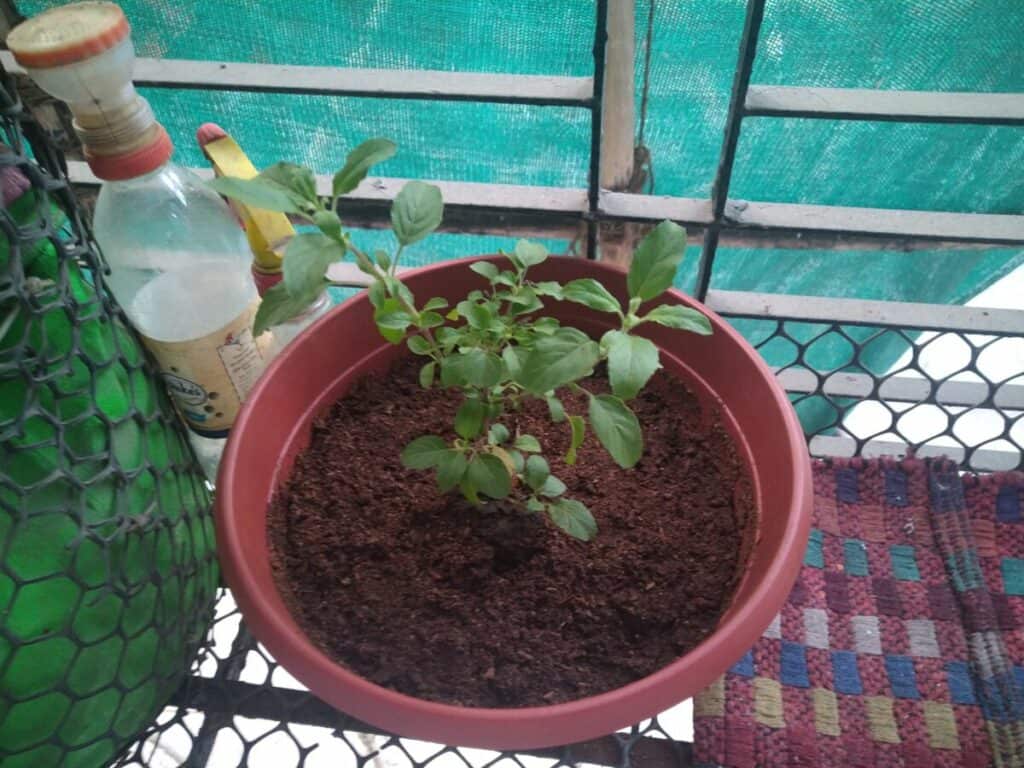
Where can you buy basil seeds?
You can buy cilantro seeds from your local garden center or nursery. There are also a lot of online stores that sell several varieties of cilantro seeds.
I’ve listed some of the cilantro seed varieties you can buy along with the temperatures they need and the height they will grow. Check the seed packets for the best information about the plants.
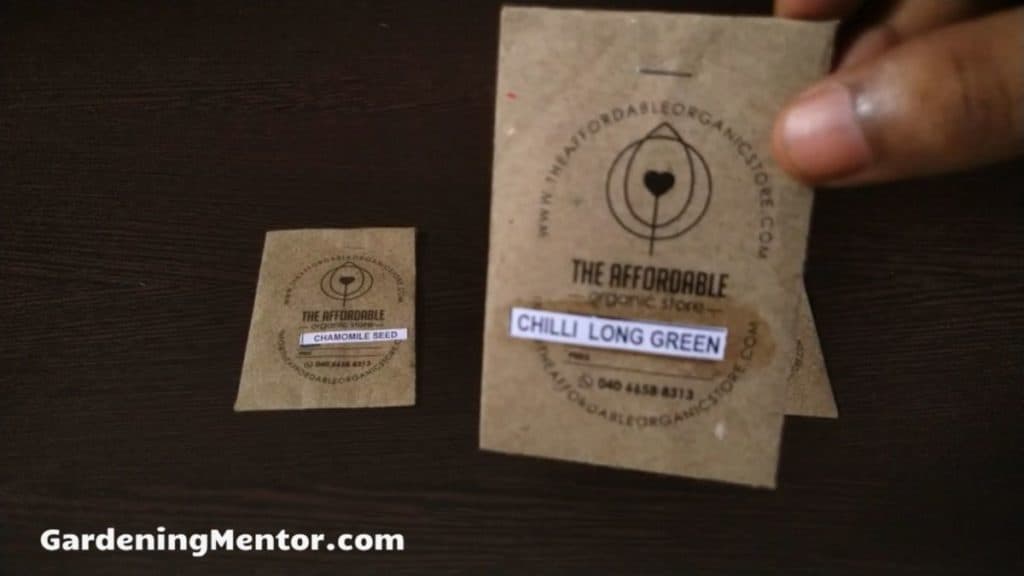
| Seed variety | Temperature | Height | Days to maturity |
| Holy basil | 65-70 °F | 12-14 inches | 90-100 |
| Genovese basil | 65-70 °F | 24-30 inches | 70-75 |
| Greek basil | 65-70 °F | 8-10 inches | 60-90 |
| Thai basil | 65-70 °F | 12-16 inches | 65-70 |
| Dark Opal basil | 65-70 °F | 15-20 inches | 70-80 |
| Lemon basil | 65-70 °F | 20-24 inches | 60-70 |
| Sweet basil | 65-70 °F | 14-30 inches | 65-70 |
| Cinnamon basil | 65-70 °F | 25-30 inches | 65-70 |
| Christmas basil | 65-70 °F | 18-20 inches | 55-60 |
| Spicy bush basil | 65-70 °F | 8-10 inches | 50-55 |
When is the best time to plant basil?
Basil likes to grow in cool weather. This means it’s best to plant them when the temperatures are in the 50 to 80 °F range.
If the temperature goes below 50 °F in the day or night, the basil plant will either not germinate or freeze to death. If the temperature goes above 80 °F, the basil plant will bolt to produce flowers and seeds making it inedible.
I would suggest the best time to plant your basil seeds is either in spring after the last frost date. Or you can plant after summer just as the weather starts getting cooler.
Basil plants grow quite fast like other herbs which means you can get multiple harvests growing many batches of the plant.
How to choose a pot to grow basil?
Basil needs a decent space to grow well so we need to choose a pot with sufficient space. The pot you choose should be 8-12 inches deep. This helps the basil roots to grow deep searching for the nutrients and moisture.
The width of the container you pick depends on how many basil plants you want to grow in one pot. If you want many plants in one pot, you’ll need a pot that is at least 18 inches in width.
Keeping good space between the basil plants helps them spread their roots and prevent competing for resources. It also helps with air circulation through the plants avoiding problems caused by humidity.
You can get a pot made from different materials like plastic, terracotta, ceramic, metal, or concrete. You can pick anyone you prefer but I would recommend a plastic pot if you want to be able to move it around. The plastic pot is lightweight, durable, and inexpensive.
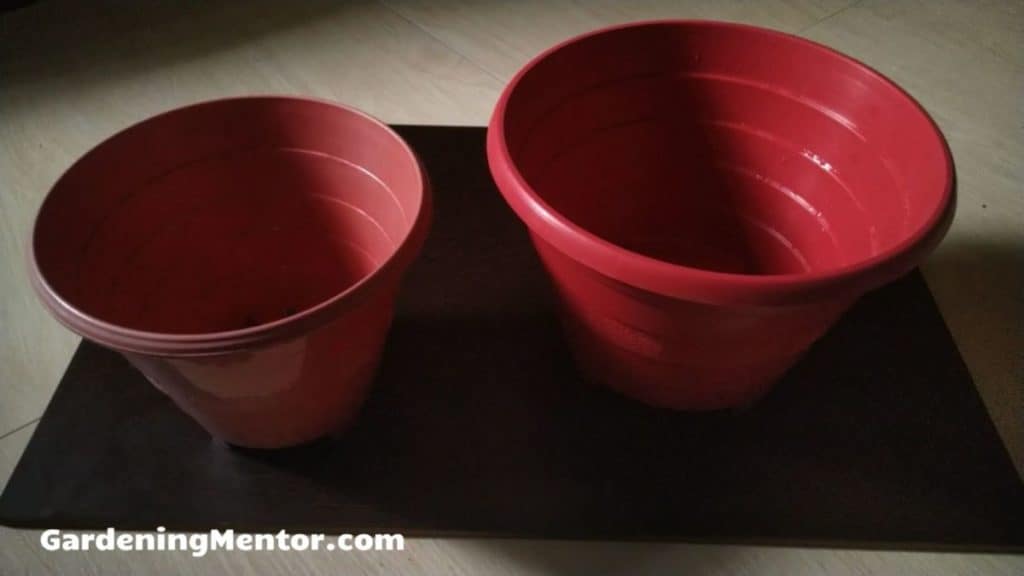
Terracotta pots are good but you need to be careful when watering the plants. The material is porous so the pot loses moisture quicker than other types. This means you may need to water the basil plants more often.
You also get grow bags that are an alternative to using a pot. These can be convenient as they are lightweight, durable, and inexpensive. And easy to fold and store once you’re done with the growing season.
Whether you buy a new pot or reuse an existing one, always make sure to wash the pot before use.
I would suggest rinsing the pot in a mix of 1 part bleach and 9 parts water for at least an hour. This gets rid of unwanted pests and diseases that may be left over in the pot. Then wash the pot well with water and dry it before planting the basil seeds in it.
The pot should also have drainage holes at the bottom so you don’t end up drowning the basil roots. If you don’t get a pot that already has such drainage, you can drill some holes with a drill machine.
I’ve researched some plastic pots you can use for growing basil plants.
| Name | Width | Height |
| Novelty Round Pot | 10.25 inches | 9.8 inches |
| Bloem Saturn Planter | 9.75 inches | 8.5 inches |
| Fiskars Planter | 13 inches | 10.25 inches |
| Bloem Freesia Planter | 12.5 inches | 11 inches |
| La Jolíe Muse Pot | 14.2 inches | 10.6 inches |
Which potting soil should you use?
The best soil you can use to grow basil plants in pots is a good potting mix that has good texture. This helps the air and moisture to reach the roots while the excess drains out.
I would suggest not to use soil from your garden because it may contain clay or sand that is not suitable for growing basil. It may also contain pests, diseases, or chemicals that will be harmful to the plants and your health.
Once you’ve bought the potting mix, fill the pot with it. Make sure to leave 1-2 inches from the top of the pot empty. This helps avoid the water and soil flowing out of the pot when you’re watering the basil plant.
The basil seeds will have sufficient nutrients to grow and germinate. But once the seeds have germinated and grown a few inches, you’ll need to help the plant with a little fertilizer.
If you have compost available, that’s a good choice to add to your potting mix when preparing the pot and soil. The compost has the required nutrients and microorganisms beneficial for the basil plant.
If you don’t have compost, you can add a slow-release organic fertilizer to the potting mix when preparing the pot. This fertilizer will release into the soil slowly after each watering you give. The fertilizer can be a balanced one with N-P-K values of 5-5-5 or 10-10-10.
Here’s a list of potting mixes that would be suitable for growing your basil plants.
- Fox Farm Happy Frog Organic Potting Mix
- Burpee Natural Organic Premium Growing Mix
- Black Gold All Purpose Potting Soil
- Perfect Plants Organic Potting Mix
- Espoma Organic Potting Mix
How to plant basil seeds in the pot
It’s easy to plant the basil seeds directly in the pot, unlike some other herbs. So we will use this method. It’s simple and you don’t need to use a seed-starting tray.
Water the potting soil well before you plant the basil seeds. Make sure the soil is moist but not damp or wet.
Place the seeds in the soil at a slight distance from each other. You can place 2-3 seeds together because we can thin them later. You can then cover them with a little potting mix so the seeds are 1/4th inch below the soil.
It’s important to keep the seeds moist so they have the best chance of germination. You need to water them every day with a spray to do this. The basil seedlings will germinate in about 2 weeks’ time.
Where to place the pots?
You want to grow basil plants where there’s at least 6-8 hours of sunlight. But you need to be careful it’s not too hot. Or the plant will bolt producing flowers and seeds.
Placing the pot in indirect sunlight is a good option. And when it becomes too hot, you can move the pot in an area of your garden or house that has shade.
How to water basil plants
The basil seeds don’t like to stay dry for long. That’s why you need to keep the potting soil moist and the best way is to spray water on the soil.
Once the seedlings have germinated to a few inches, you can use a watering can to pour water on the potting soil. Be careful not to pour too much water as overwatering is a common problem with container gardening.

There’s an easy way for you to know if the potting soil has become dry and needs watering. Stick 1-2 inches of your finger into the soil. If the tip of your finger does not feel moisture, the soil is dry and you need to give it a good watering.
Water the soil well till it drains out from the bottom of the pot through the drainage holes. This means that the water is reaching deep into the soil to the roots.
Rainwater is the purest form of water and does wonders for the basil plants. But you need to collect and store it in a rain barrel. The other option is to use a distiller at home to get distilled water.
It’s OK to use tap water as well but you need to leave it in a container for at least 12 hours. This helps dissipate the chemicals you find in tap water such as chlorine and fluoride. These chemicals are harmful and stunt the growth of basil plants.
I like to water the plants in the morning before the sun rises. This helps the water to reach the roots before the heat from the sun evaporates it.
I would suggest being careful when watering the basil plants with the watering can. Make sure to only water the soil near the base of the plant and not splash water on the foliage. That can create a moist condition leading to fungal diseases like powdery mildew.
Here’s a list of watering cans you will find useful for watering your basil plants.
- Bloem Aqua Rite Watering Can
- Novelty Watering Can
- Cado Watering Can
- Gardener’s Select Watering Can
- Calunce Watering Can
How to thin the basil seedlings
The benefit of starting basil seeds is you grow several of them together. Then once the seedlings have germinated you can thin them out.
Thinning is a process where you cut out the unwanted and weak seedlings that have germinated while letting the healthy seedlings continue growing
This helps reduce the number of seedlings so they don’t compete with each other for nutrients and moisture. It also helps increase the space between the basil plants so there’s good air circulation and sunlight reaching the foliage.
The best time to start thinning the seedlings is when they have grown 2-4 inches tall. You can see a couple of the leaves have grown on the seedling.
Cut out the seedlings that are the weakest and let the others remain in the soil. To do this, hold the base of the seedling and cut it out with a pair of gardening scissors.
You can use the seedlings you cut out in your salad or you could add them to your compost pile if you have one.
How should you prune the basil plants?
Once the plants have grown to a few inches height, its time to start pruning the foliage. It’s good to do this because you can cut off diseased or pest-infested portions of the plants.
Pruning also helps the basil plants focus their energy on growing new leaves rather than the flowers or seeds.
Pruning is a method where you cut off the mature leaves and use them for your consumption while leaving the other portions of the plant. This encourages the plant to continue growing.
The best way to prune is to place your thumb and forefinger on the stem and pinch it off. You don’t want to pull on the plant but just gently pick off the stalk you need.
It’s good to use a pair of pruning scissors so you avoid damaging the plant too much. The wound heals faster and there’s less risk of a disease infecting the plant.
Once you’re done with the pruning, you can add a little bit of potting mix and compost to the plants. This will give them the boost of nutrients they need to grow back again.
Here are some gardening pruners you can use for pruning your basil plants.
- VIVOSUN Hand Pruners
- Fiskars Micro-tip Pruner
- GROWNEER Pruning Shears
- Felco Pruning Shears
- Corona Long Straight Snip
Does basil need fertilizer?
Organic compost is the best food or fertilizer you can add to your basil plants. You need to mix it with the potting mix when preparing the pot.
The compost contains rich, organic nutrients that are beneficial to the basil plant. It also contains beneficial microorganisms that improve the soil-food web that improves the soil even further.
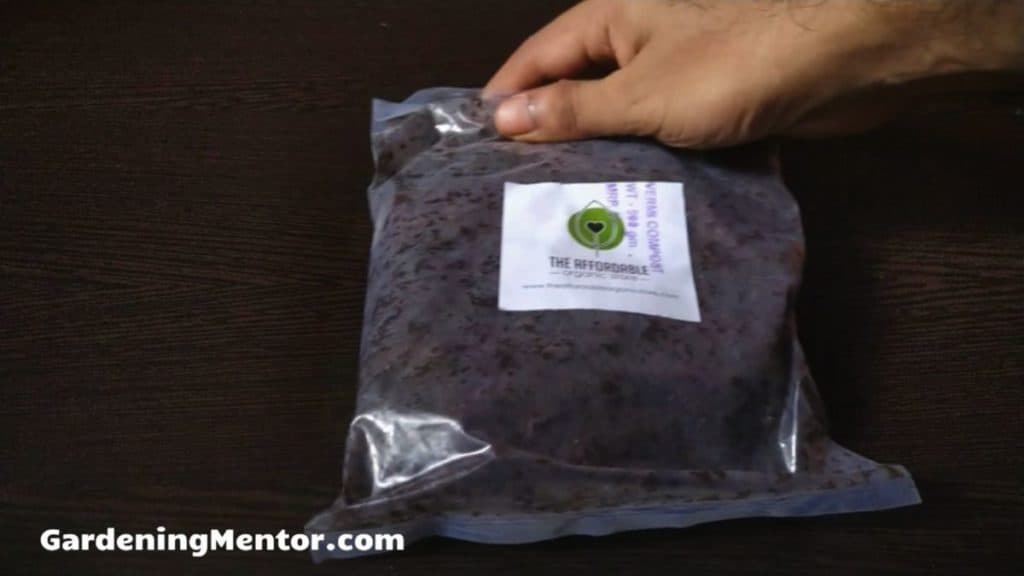
Once the plants have grown to about 2 inches, you can continue adding a little bit of compost to the soil every month.
If you can’t get compost, slow-release organic fertilizer is also a good choice to add to the potting mix as you prepare the container. Watering the potting mix will slowly release the fertilizer and make it available to the basil plant.

Make sure to follow the instructions provided by the manufacturer on how much and how often to use the fertilizer.
You can add the slow-release fertilizer once more when the plants have grown 2-4 inches so the nutrients are available during the growing period. Or you can add an organic liquid fertilizer every two weeks.
Spray the liquid fertilizer on the soil as well as the foliage to give the plants a boost of the nutrients they need.
The fertilizer you choose can be high in nitrogen as this is beneficial to speed up the growth of plant foliage. Something like fish emulsion does a good job of adding nitrogen to the potting soil.
You need to be careful not to overuse the fertilizer on your cilantro plants as it will cause leaf or root burn that will kill your plants.
Here is a list of slow-release organic fertilizer you can use.
Here is a list of organic liquid fertilizer you can use.
- Neptune’s Harvest Organic Fish & Seaweed Fertilizer
- Espoma Organic Grow Fertilizer
- FoxFarm Grow Big Liquid Fertilizer
How to protect basil from weeds
Weeds are not a big problem when you’re growing basil in a container compared to growing it in the ground.
But it can still be an issue because the wind carried some weed seeds into the pot or some birds dropped them in.
The best solution to the problem of weeds is to add a layer of mulch to the pot. This could be organic material like grass clippings from the lawn, dried leaves from the yard, or moss you collect near the house.
It’s best to add the mulch only after the basil seedlings have grown about 2-4 inches tall. The mulch blocks the sunlight from reaching the weed seeds and prevents them from germinating.
The mulch is beneficial to the basil plants because it keeps the moisture in the soil to last longer. It keeps the soil temperature regulated so it does not become too hot or too cold for the basil plant.
I suggest using organic mulch because it will slowly break down into organic matter and add beneficial nutrients to the potting soil.
How to harvest basil
Basil will grow fast in the container so you can harvest the leaves as soon as the plant has grown in about 3-4 weeks after sowing the seeds.
The plant should be at least 4-6 inches tall when you start harvesting the leaves. The benefit of harvesting herbs is the more leaves you harvest, the more they continue to produce.
You only need to make sure to harvest a few of the leaves and keep the rest so the plant can continue to grow and produce more leaves.
It’s best to harvest the leaves from the top by pinching them off with your thumb and forefinger. You can also use a pair of gardening scissors to cut them off with ease. This helps ensure you’re not pulling the plant and causing damage to it.
I would suggest adding some compost and potting mix near the base of the plants once you’re done with the harvesting. This will give the plants a boost to grow new foliage.
You can also harvest the entire basil plant from the pot but you need to wait till they mature after 50-70 days depending on the variety and seeds you purchased. Check the seed packet to know what is the maturity date for your basil plant.
You need to use the gardening scissors or pruners to cut near the base of the plant for harvesting it.
How to store basil
Many herbs including basil taste the best when you consume them fresh. The moment you harvest the leaves from the plant is the best time to add them to your food. So harvest the leaves once you need them.
But there are ways you can store the harvested basil leaves in the refrigerator for weeks and even months.
I’ll show you one way to freeze the basil leaves in the refrigerator to last you a couple of months. You can take out how much you need for your use in the kitchen.
- Clean the harvested basil stalks with water to remove any dirt from them.
- Place the individual stalks on a paper towel to dry them well.
- Separate out the leaves from the stalks. You can use the stalks in your cooking or dispose of them.
- Place some baking paper on a baking tray. Then place the leaves on the baking paper so they are separated from each other.
- Place the baking tray in the freezer for 30 minutes so the leaves are frozen. This is done so the leaves don’t stick to each other when you store them.
- Take the baking tray out of the freezer and use a plastic freezer bag to put the cilantro leaves in it. Do this immediately before the leaves with thaw and stick to each other.
- Take the air out of the plastic bag so the basil leaves don’t dry out.
- Store the plastic bag in the freezer and the leaves can last for 2 months.
- You can take the individual leaves out of the plastic bag for your use in the kitchen.
Pests and diseases that affect basil
Herbs tend to have a stronger defense against pests and diseases than other plants. But they still can be affected.
It’s great to grow basil in a pot because it remains isolated from the other plants. This helps lower the chances of getting infected by pests and diseases from other plants.
The best way to protect your basil plants from fungal diseases is to avoid splashing water or soil on its foliage. And keeping a good distance between plants so air circulation is well-maintained.
Every day as you water the plants you can monitor the basil plant for signs of pests and diseases. This helps you take immediate steps in case of a problem and solve it as soon as possible before it becomes a larger issue.
Pests
Aphids: Aphids are a common pest you can find on herb plants. They attack the leaves and suck the sap from them. You can usually find them underneath the leaves. They come in different colors like green, white, yellow, red, and orange. It’s easy to get rid of aphids by spraying water on them and dropping them into the soil.
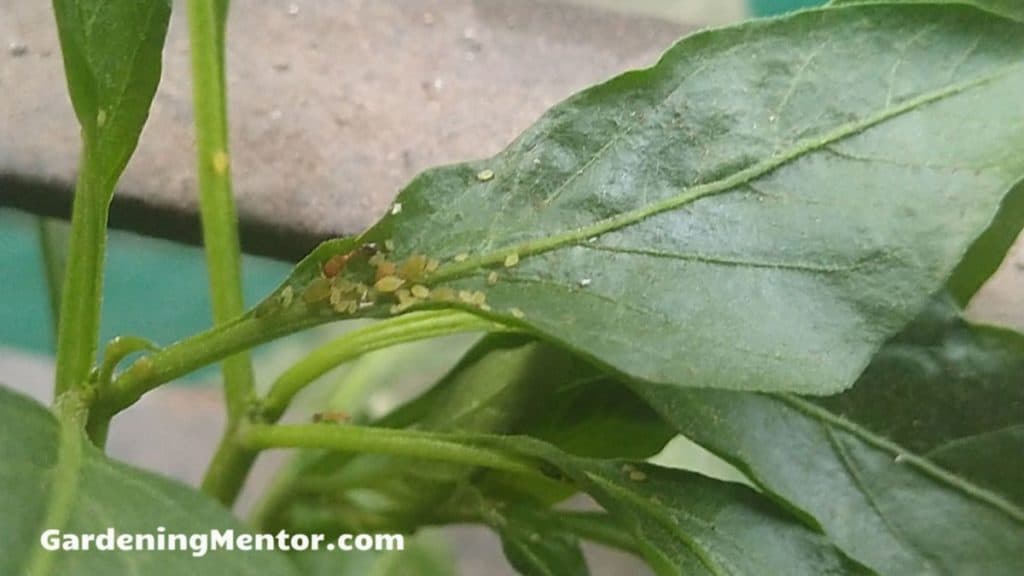
Cutworms: Cutworms are larvae of adult moths you may find on your basil plants. They come in different colors like black, green, pink, or grey and may be solid, spotted, or striped. The main damage they cause is eating the stem or roots of the plant and killing them. To protect your basil plants from these insects cover the stem with a toilet paper tube.
Root-knot nematode: These microscopic creatures are present in the soil and feed on the basil plant’s roots which cause them to develop rounded galls. The solution to this pest is to dispose of the basil plant and potting soil.
Diseases
Bacterial leaf spot: The bacterial leaf spot causes black or brown spots on the leaves of basil. These spots can get larger and the leaves may wilt. The only solution is to prevent this disease by avoiding humid conditions in the garden and the plant. Avoid splashing water or soil on the foliage. You can also pick a basil variety that is resistant to this disease.
Powdery mildew: Powdery mildew is a fungal disease that infects basil plants leaving a white-gray powdery growth on the leaves. If the infection is severe it will cause the leaves to brown and drop. To prevent this problem avoid moisture on the leaves caused by splashing water on them.
Soft rot: Soft rot is another bacterial disease caused by a moist environment. It affects the plant’s tissue making it soft and wet. Again, the best cure is prevention by being careful while watering. Avoid splashing water on the foliage that causes moist conditions on the leaves.
Fact Checked, Written, and Published by Kevin Rodrigues
Kevin is the founder of Gardening Mentor, a website that aims to teach people to grow their own food in a limited space. As a self-taught gardener, Kevin has spent several years growing plants and creating gardening content on the website. He is certified in Home Horticulture and Organic Gardening from Oregon State University. He has a Post Graduate Diploma in Horticulture and Landscape Gardening from Mumbai University.
Read more


